Table of Contents
In recent years, Bureau of Mines projects under the sponsorship of the National Aeronautics and Space Administration (NASA) have explored various aspects of the problems associated with establishing habitable stations on the Moon. The rapid advances in space technology, and particularly the success of the Apollo missions, indicate it is within reason to envision lunar facilities manned by large numbers of personnel. To provide oxygen for a life-support system for the inhabitants of these installations and for other uses, it is obviously desirable to utilize extraterrestrial resources as much as possible, and a potential source of oxygen is the lunar surface material itself. Analyses of lunar rocks returned to earth by the crew of Apollo 11 showed that these materials were substantially different in composition than the most closely analogous terrestrial materials. Among these differences was a relatively large concentration of iron and titanium, and a lesser concentration of silicon and aluminum. These materials, nevertheless, contained about 40 weight-percent oxygen, comprised primarily of oxides of silicon, iron, titanium, calcium, aluminum, and magnesium. Although many of these oxides are highly stable, attractive possibilities exist for extracting oxygen from them by means of a high-energy process such as molten-salt electrolysis. This would involve modification of the basic concepts and techniques developed for the preparation of various reactive metals by the conventional high-temperature electrolysis methods.
The feasibility of metal production by electrolysis in molten-salt media has been widely demonstrated. Many of these procedures, such as the Hall process for aluminum, involve the dissolution and subsequent reduction of an oxide of the metal in question. The technique has also been demonstrated for preparing uranium, thorium alloys, and several of the rare-earth metals. In these methods, the anode reaction involved the discharge of oxygen ions at a carbon electrode and the resultant formation of carbon oxides, which consumed the electrode.
The objective of the present investigation by the Bureau of Mines was to extend the electrolytic technique to silicate-bearing mixtures. In this procedure, oxygen-bearing anions would be discharged at a nonreactive anode, producing elemental oxygen, which is evolved from the cell. The cathode reaction could entail the reduction of several metal-bearing cations and the subsequent codeposition of these metals as dendrites or low-melting alloys. These reactions are presented below in simplified form, using the reduction of titanium dioxide as an example;
TiO2 → Ti + O2↑ (overall reaction)
Ti4+ + 4e- → Ti (cathode surface)
2O2- → O2↑ + 4e (anode surface)
In theory, electrolysis could also produce oxygen through the discharge of silicate anions as shown by the following reactions proposed by Bockris;

Electrical conductivity and viscosity studies have been conducted at temperatures up to 1,800° C by Bockris and associates on binary mixtures of SiO2 and metal oxides of the alkali and alkaline-earth groups and others such as aluminum, iron, manganese, lead, and titanium. From the results of these investigations, it was determined that electrical conductance in these systems was primarily ionic. The conductance increased with the concentration of the metal oxide and was a function of the network-breaking effect of the metal oxide. Bockris also demonstrated that passage of direct current through the melt produces electrolysis, and in many of the systems, Faraday’s laws are obeyed within experimental error.
In a research study of electrical conduction in liquid iron silicate slags, Simnad, Derge, and George electrolyzed various iron oxide-silica mixtures. Results of their research established that oxygen was evolved at the anode during electrolysis, with the proposed reaction being represented by the previously shown equation for the orthosilicate structure. Calculated current efficiencies of near 90 percent were attained; however, the preparation of elemental oxygen was not the primary objective of their work, and the oxygen evolved at the anode was allowed to react with an iron anode lead wire to form iron oxide.
Silicate rocks selected for use in the initial phase of this study included several of the standards suggested by Green as being representative of possible lunar surface materials. These included a basalt, an obsidian, a granodiorite, and a serpentine. Major emphasis, however, was directed toward the electrolysis of mixtures containing volcanic scoria.
The results of preliminary efforts at the Reno Metallurgy Research Center to extract oxygen from silicate-bearing mixtures were described in a progress report. This paper recapitulates the essential findings of the earlier study, and details the results of subsequent experimentation.
Equipment and Materials
Cell and insulation components were enclosed in a 3-foot-diameter by 4-foot-long steel chamber. Essential features of the chamber are shown in figure 1. It was equipped with viewports, lead throughs for bringing ac and dc power into the chamber, and had a full-diameter access door at one end. Manipulation of the electrode hoist mechanism was accomplished through gloveports and neoprene gloves. The chamber could be evacuated to a pressure of about 10-³ torr at ambient temperature by means of a mechanical pump. A refrigeration unit was available to cool the chamber atmosphere to permit the performance of necessary manual operations.
An arc welder furnished alternating current applied to the resistor for heating the cell, and a silicon rectifier supplied the direct current for electrolysis. Temperatures of the electrolyte surface were measured with an optical pyrometer.
The electrolytic cell and insulation system were constructed as much as possible of refractory materials, which would not react with oxygen at elevated temperatures. This design is shown in figure 2. A hot-pressed boron nitride crucible, 4 inches inside-diameter by 3-½ inches deep, was used for containing the electrolyte. The selection of electrode materials for use with this cell was the subject of research, which is described later in the paper.
Thermal insulation was provided by castable alumina and firebrick. Six silicon carbide resistors heated by alternating current supplied the requisite heat.
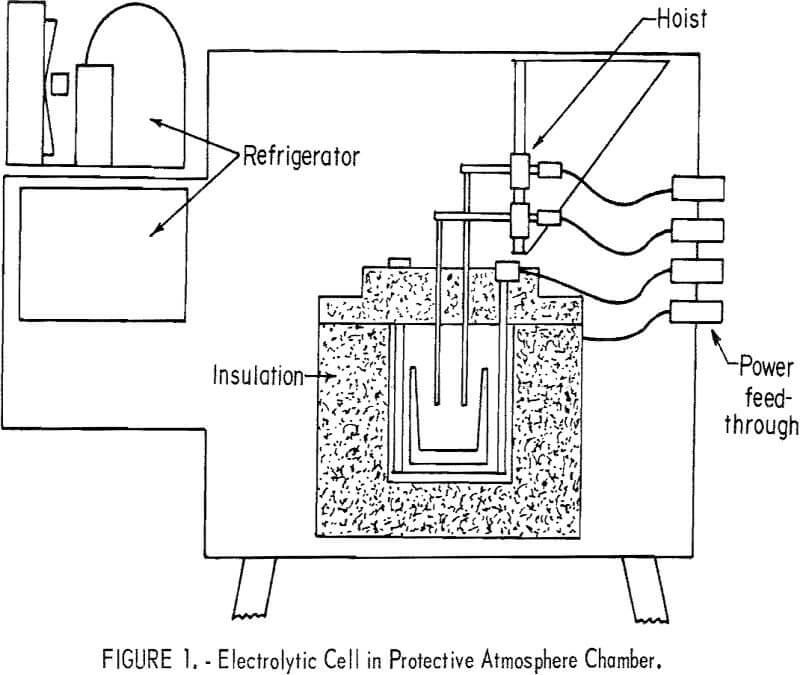
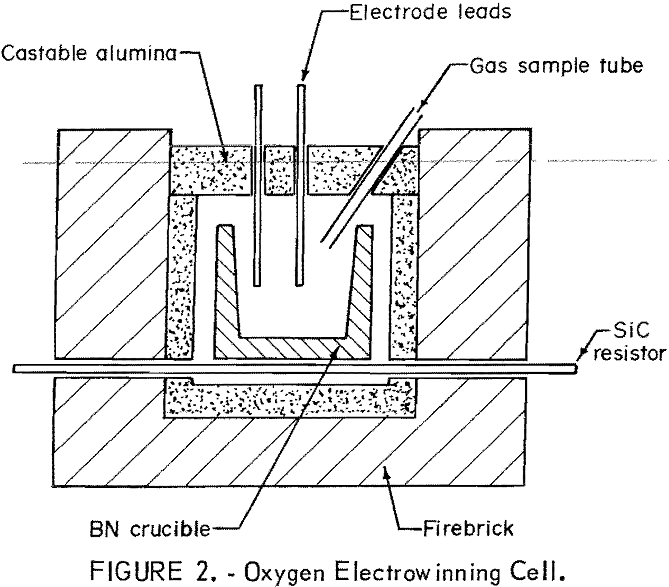
The volcanic scoria used as the oxygen source in the electrowinning experiments came from a deposit in western Nevada. Mineralogical examination of this material showed it to be typical of scoria found on basaltic cinder cones. The scoria was highly vesicular and had a varying number of voids relative to the amount of matrix material. The matrix material was an iron-rich, oxidized, and partly devitrified volcanic glass that contained 20 to 30 percent plagioclase feldspar. Occurrence of the feldspar was as lath-shaped, euhedral crystals ranging in size from 0.25 by 0.05 millimeters to 0.01 by 0.005 millimeters or smaller. Some minute (<0.01 mm) grains of opaque material, probably ilmenite or magnetite, and some oxidized grains that may have been iron-rich silicates were also present. The elemental composition of this material based on the dry state is compared in table 1 with that of a sample of vesicular lunar rock.
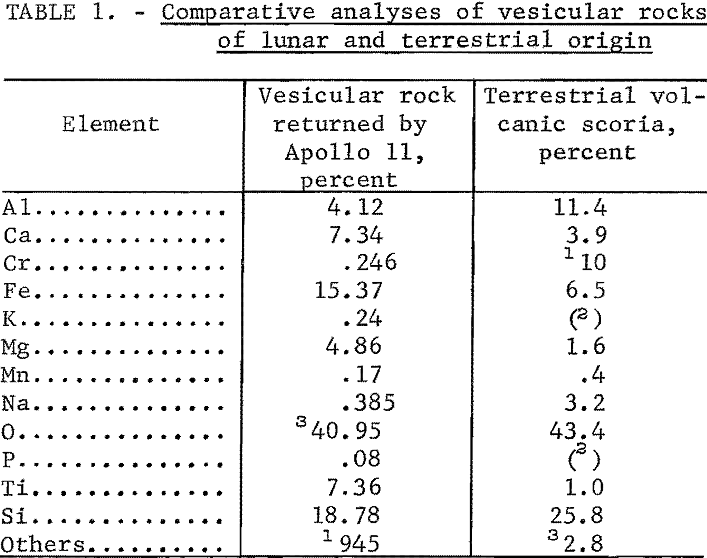
For the purpose of these investigations, the purity of the chemicals used as fluxing agents was not critical; therefore, the majority of these materials were of technical grade.
Procedure
Before assembling the cell components, the electrolyte constituents were dried to remove adsorbed moisture. After the cell components were assembled within the chamber, the cell was degassed by heating it to about 650° C in a vacuum of about 10-³ torr. The chamber was then backfilled with helium.
The electrolyte was melted by heat from the silicon carbide resistors. About 15 kilowatt-hours were required to heat 1,000 grams of bath to 1,100° C. After the desired bath temperature was attained, electrolysis was initiated by applying direct current to the electrodes, and the input to the resistors was adjusted as necessary to maintain the heat balance in the cell. Cell gases were sampled at a point near the anode and analyzed for oxygen to an accuracy of ±0.1 percent by the Orsat method. Analysis for the presence of other gases was accomplished by infrared spectrophotometry and by gas chromatography.
After each experiment, the electrodes were withdrawn from the melt, and the cell was cooled to room temperature for disassembly and examination.
Results and Discussion
Initial experimentation showed that electrolysis could not be effectively performed in silicate mixtures without the addition of fluxing materials to promote fluidity and electrical conduction of the melts. These investigations were conducted at 1,500° to 1,775° C in a special high-temperature cell on volcanic scoria, pumice, granodiorite, and basalt. Similar studies were also conducted on selected synthesized minerals, including diopside, wollastonite, clinoenstatite, monticellite, and anorthite. In all instances, the melts exhibited excessive fuming, remained highly viscous, and had negligible electrical conductivity.
In a subsequent study of various fluxing materials, several fluoride, oxide, borate, and phosphate compounds were evaluated as additives for improving the electrical conductivity of the volcanic scoria melt. In these experiments, conducted at 1,300° C, 3/8-inch-diameter graphite rods spaced 2 inches apart were immersed 1 inch into the bath. The amperage was then measured at an applied potential of 10 volts. The results are summarized in table 2, in which the conductivity is evaluated in terms of amperage-to-voltage ratio. As indicated, the lithium fluoride-bearing melt was the most conductive.
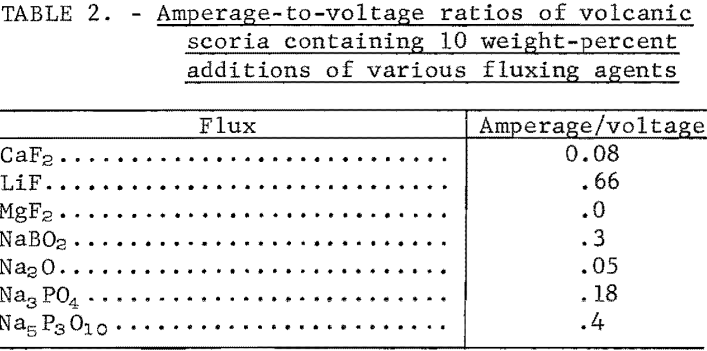
Evaluation of Electrode Materials
Because of the corrosive nature of the silicate-fluoride melts, an extensive study was conducted to evaluate the compatibility of various refractory materials with the molten baths. The initial phase of the investigation was on the corrosion resistance of iridium and platinum in melts composed of silicates fluxed with additions of 10 weight-percent LiF and heated to —1,500° C. In this temperature range, both metals were severely corroded after only a few minutes of immersion. However, in compatibility studies conducted at 1,250° C in a melt composed of 25 weight-percent silicate, 69.4 weight-percent BaF2, and 5.6 weight-percent LiF, iridium showed very good corrosion resistance under static conditions in which a voltage was not applied to the electrode. Subsequent efforts were directed toward determining the corrosion resistance of several refractory materials under the influence of an applied dc potential. In addition to iridium, silicon carbide and titanium and zirconium diborides were evaluated for use as anode and cathode materials in various fluoride-bearing silicate mixtures at temperatures up to 1,250° C. Iridium exhibited the best stability of these materials when used as an anode, and silicon carbide was inert as a cathode material. Severe corrosion of both diborides occurred regardless of the polarity.
Electrowinning Experiments
Initial experiments to electrowin elemental oxygen used an electrolyte composed of 25.0 weight-percent volcanic scoria, 69.4 weight-percent BaF2, and 5.6 weight-percent LiF. Iridium sheet 0.02 inch thick, with a surface area of about 0.45 square inch on a side, was used as the anode, and the cathode was a ½-inch-diameter silicon carbide rod. Electrolysis was conducted at 1,150° to 1,250° C, and at 17 to 19 volts. The electrolysis current was temperature- dependent and ranged from 25 amperes at lower temperatures to more than 60 amperes at temperatures near 1,250° C. During these experiments, up to 5.0 volume-percent oxygen was attained in the cell gases after 30 to 40 minutes. The remainder of the gas was primarily the ambient helium, with trace amounts of CO2 and SiF4. The carbon dioxide was a product of the reaction between oxygen and the SiC cathode or heating elements, while the SiF4 may have resulted from a reaction between the SiC cathode and fluoride fluxing agents.
A considerable improvement in results was achieved by utilizing a bath composed, in weight-percent, of 35.0 volcanic scoria, 48.5 BaF2, and 16.5 LiF. The higher LiF content permitted electrolysis at 1,050° to 1,150° C, with no significant change in the voltage-amperage relationship. The maximum oxygen content of the gas over the cell during these experiments was 6.9 percent by volume.
Fuming occurred with this electrolyte but was less severe than with some of the other bath compositions. A major contributor to the fuming was the relatively volatile lithium fluoride, and analyses indicated that about 1 to 1.5 percent of the fluorine content of a melt weighing 800 to 1,000 grams was lost after 4 to 5 hours of electrolysis. In general, however, the overall operating characteristics of this electrolyte were superior to others evaluated, and it was used in all subsequent experiments.
Increasing the anode surface area to about 0.85 square inch resulted in a further improvement in cell performance, and oxygen contents of more than 14 volume-percent were achieved. Table 3 compares the conditions and results of typical experiments in which the anode area was 0.45 square inch, with those from experiments in which the area was 0.85 square inch.
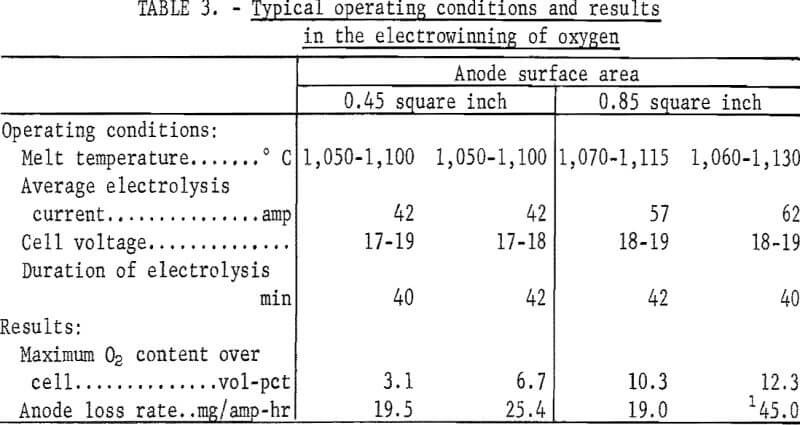
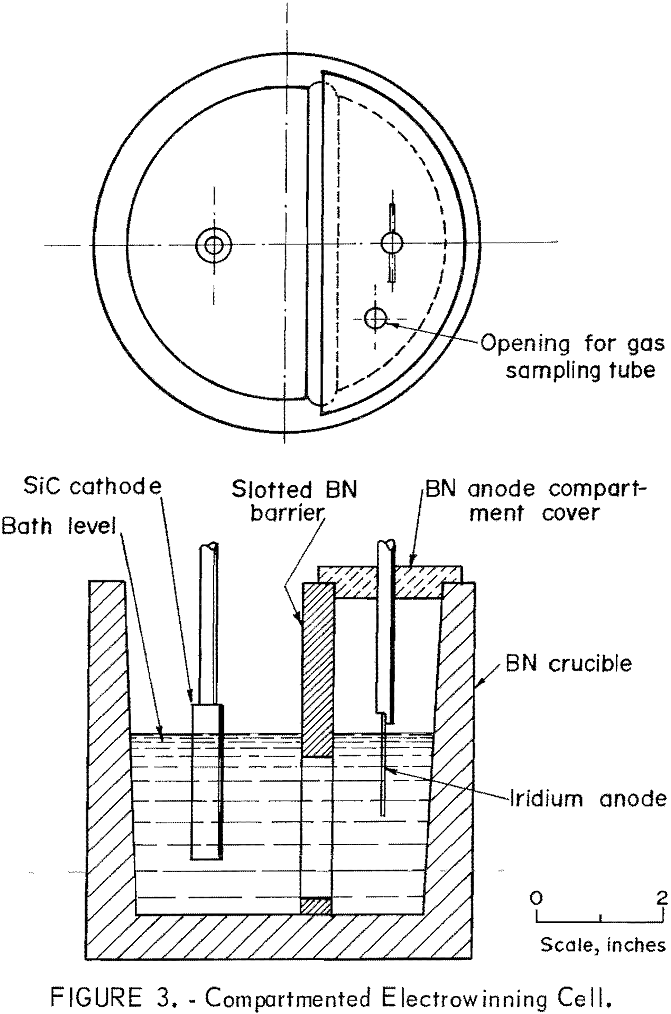
Following these studies experiments were conducted under conditions that would permit the quantitative determination of the oxygen evolved at the anode during electrolysis. For this purpose, a modified electrolytic cell was designed as illustrated in figure 3. The crucible was divided into anode and cathode compartments by means of a boron nitride barrier, slotted below the bath level, and solid above. A tight-fitting boron nitride lid over the anode compartment was designed to restrict the gases evolved during electrolysis to the volume defined by this compartment. Thus, by periodic analyses of these gases, the oxygen yield and faradic efficiency of the cell could be calculated. Although the electrode lead-through and gas sampling tube were sealed into the lid to prevent gas leakage, experimentation-indicated that an unknown amount of leakage was occurring. This prevented the quantitative determination of the oxygen yield by means of gas analysis, and the emphasis was redirected toward efforts to make semiquantitative determinations of the yield. This was accomplished by using materials balance data over a period of several experiments, in combination with analyses of the electrolyte and cathode products.
This phase of the research consisted of a series of experiments, each entailing seven to nine 30-minute electrolysis periods. Operating conditions were as follows: A temperature of 1,100° to 1,160° C, a current of 35 to 50 amperes, and a voltage of 17 to 19. After each period, the SiC cathode and adhering deposit were removed and replaced by a new cathode.
During these experiments, electrolysis was conducted for a total of almost 570 ampere-hours. Based on an electrochemical equivalent of 0.29845 gram oxygen per ampere-hour, the theoretical oxygen yield was about 170 grams.
Subsequent analyses of the electrolytes and cathode deposits, including the trapped electrolyte, showed that these materials contained about 94 grams less total oxygen than was present in the starting electrolytes. From these data, the calculated average anode current efficiency was 55 percent. Operating conditions and results from these experiments are summarized in table 4.
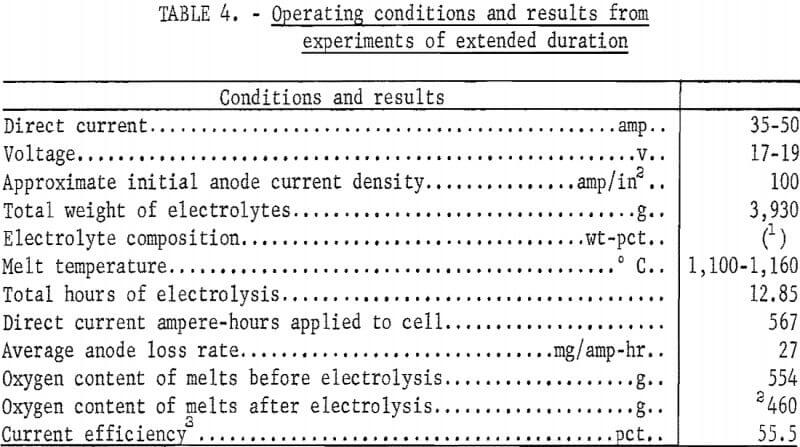
In all experiments, a solid deposit of varying size accumulated on the cathode. This material consisted of metal dendrites and entrapped electrolyte, and most had magnetic properties. Although accurate analysis of the metal portion of the deposits was impractical because of the adhering bath, spectrographic analyses of selected dendrites, which were relatively free of bath materials, showed iron, aluminum, sodium, silicon, and barium as major constituents. Also present in significant quantities were manganese, titanium, calcium, molybdenum, and boron. Nickel, zirconium, copper, and chromium were present in lesser amounts. The boron probably originated from the boron nitride crucible, and the molybdenum may have come from the tools or electrode connecting rods.
Comparison of these data with analyses of electrolytes that had been used in several experiments provided some indication as to which of the above elements were present as metals electrodeposited on the cathode, as opposed to those present as metal oxides in the adhering electrolyte. The latter analyses showed a substantial decrease in the iron, titanium, vanadium, cobalt, nickel, and chromium contents of the electrolytes. Of these elements, 95 to 98 percent of the iron, and 50 to 65 percent of the titanium and vanadium were removed from the baths. Cobalt, nickel, and chromium were not detected in the electrolytes following electrolysis; however, the overall contribution to the oxygen product made by electroreduction of their oxides was negligible, since none of these elements was initially present to the extent of more than 50 parts per million. Other elements such as aluminum, magnesium, manganese, and sodium were decreased to a lesser degree; the remainder were essentially unchanged. Of particular significance was the apparently minor contribution to the oxygen product made by reduction of the silica in the electrolyte.
The rate of loss of the iridium anodes ranged from 12.5 to about 60 milligrams per ampere-hour. In some experiments, the loss was not due entirely to electrochemical processes, or to oxidation, but was due partially to contact between the cathode growth and the anode. Alloying between the iridium and some of the metallic constituents of the cathode deposit caused severe embrittlement of the anode, and promoted nonuniform corrosion. This problem was effectively eliminated by using the compartmented cell, as the barrier prevented the cathode deposit from contacting the anode. In these experiments, the resulting corrosion of the iridium was very uniform and the average rate of loss was about 27 milligrams per ampere-hour.
Summary
Bureau of Mines research has shown that oxygen can be electrowon from silicates dissolved in molten fluoride systems. The demonstrated ability to generate more than 14 percent by volume of oxygen in the cell gases is encouraging. Also encouraging are the data that indicated a current efficiency of approximately 55 percent.
The process has merit because of its relative simplicity and lower temperature requirements compared with other suggested methods such as the reduction of silicates with methane or with carbon. In these methods, the carbon oxides produced must be further treated to obtain elemental oxygen, whereas electrolysis yields oxygen directly.
Many of the potential problems envisioned at the onset of this research were solved. In particular, efforts to find refractory materials suitable for various components of the electrolytic unit were successful. Hot-pressed boron nitride was shown to be satisfactory as an inert and durable material for use in constructing the cells, and the silicon carbide-iridium system proved to be a workable electrode combination. Deterioration of the SiC cathodes, even over long periods of immersion, was negligible, and the iridium exhibited satisfactory corrosion resistance as an anode. For example, a loss rate for iridium of 27 milligrams per ampere-hour is only about 1.5 percent and 1.13 percent of the theoretical loss due to electrochemical dissolution, for valence changes of 4 and 3, respectively.
Despite these successes, several problems in the electrolytic process remain to be overcome, and at this stage of development, whether some of these can be adequately resolved is subject to question.
Among the problems was the fuming that occurred from all electrolytes. Additional research to evaluate other fluxing agents as substitutes for LiF might result in a reduction of the amount of volatile loss; however, it is believed that the fuming could be adequately controlled in a large-scale electrolytic unit by the use of suitable filters.
Perhaps the most serious problem is associated with cell performance over an extended period. This manifests itself as a gradual deterioration in the operating characteristics of the cell, particularly as related to the condition of the electrolyte. The deterioration was indicated by a gradual increase in the electrical resistance of the melt, accompanied by a decrease in oxygen content of the cell gas. It was speculated that this was caused by the electrowinning of metals from the easily reduced oxides present in the melt in preference to the more stable oxides such as SiO2. As the bath became depleted in these oxides, it became more difficult to maintain a favorable voltage-amperage relationship. Thus, at a given voltage, the amperage gradually decreased, causing a simultaneous decrease in the oxygen evolved at the anode.
To overcome the difficulty caused by oxide depletion and maintain a satisfactory level of cell performance would necessitate provisions for frequent renewal of the electrolyte, especially since there is apparently very little electroreduction of the major oxide constituent SiO2. The mechanics of this present no problem; however, it would require the use of large quantities of flux. Recovery of the fluoride fluxing agents from spent electrolytes must be ruled out as being prohibitively complex. Thus, unless a deposit of some suitable fluxing agent was near the lunar installation, it would mean trans-porting the flux from Earth, which is obviously undesirable.
